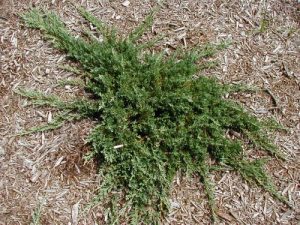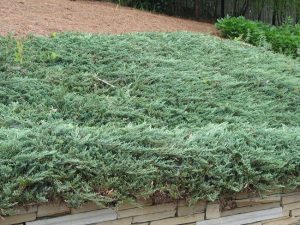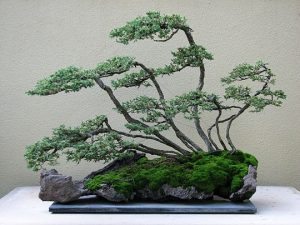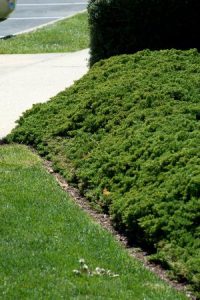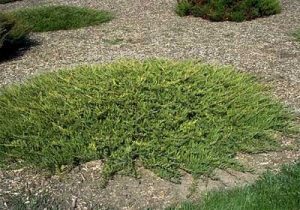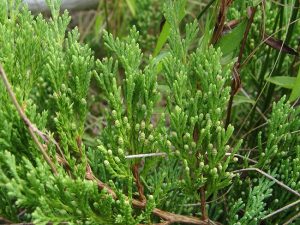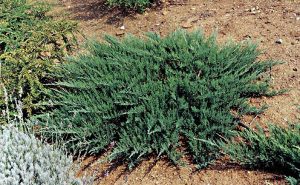Creeping Juniper
Creeping juniper is a species of graceful, aromatic, low-growing, evergreen shrubby conifers native to the boreal and subarctic regions in North America, though some populations are also scattered further south in America. Featuring plume-like horizontal branches, the creeping junipers have blue-green foliage in both spring and summer, turning into dark purple in winter.
Scientific Classification
| Kingdom | Plantae |
| Division | Pinophyta |
| Class | Pinopsida |
| Order | Pinales |
| Family | Cupressaceae |
| Genus | Juniperus |
| Scientific Name | Juniperus horizontalis |
Quick Information
| Other Names | Trailing juniper, creeping cedar, creeping savin juniper |
| Other Related Species | Juniperus virginiana, Juniperus scopulorum |
| Size | 10-30 cm tall, spread 1.8-3.1 m (6-10 ft) wide |
| Leaves | Occur in opposite crossed pairs, sometimes forming whorls of three; scale-like adult leaves (1-2 mm long, 1-1.5 mm broad) and needle-like juvenile leaves (5-10 mm long) |
| Cones | Berry-like, globular to bilobate, diameter of 5-7 mm, dark blue with bluish-white flowers having a waxy texture, usually contain 2 seeds, male cones have a length of 2-4 mm, pollens are shed in spring |
| Bark | Reddish brown, peeled, difficult to spot due to overlapping branches |
| Distribution/Range | Alberta, Labrador, British Columbia, Newfoundland I, Manitoba, Nova Scotia, Yukon, Quebec, Ontario, Saskatchewan, Northern Territories (in Canada); Iowa, Illinois, Michigan, Massachusetts, Montana, Minnesota, Colorado, New York, Vermont, Wyoming, Wisconsin, North and South Dakota (in the US) |
| Hardiness Zones | 3-10 |
| Growth Rate | Medium with an annual increase of about 4.6 cm |
| Lifespan | Moderate |
| Growing Conditions | Winter Conditions: Arid, cold climate with average January temperature of -14.5 °C to -10 °C Summer Conditions: Typically dry with great variations in diurnal and annual temperatures; average July temperature is 18.8 °C, tolerates summer drought conditions Rain: Needs low/moderate amount of rainfall, grows in areas with average yearly precipitation of 12.9-18 inches Sunlight: Grows well under full sun; tolerant to partial sunlight but may have thin foliage Soil Requirements: Medium moist, well-drained, dry, sandy, loamy, acidic or slightly alkaline |
| Diseases and Pests | Affected by root rots, phomopsis dieback, foliage blight, cedar apple rust; serious pests including juniper scale, juniper webworm, twig borers, bagworms |
| Pollination | Through wind |
| Breeding System | Dioecious |
| Seed Production | Poor seed producer; seeds are dispersed by wind and wildlife |
| Development | Staminate/pistillate cones are produced in the spring; they mature in summer/early fall |
| Wildlife Value | Mule deer, white-tailed deer, pronghorn, and other small mammals feed on this plant; birds such as rose-breasted grosbeaks, yellow warblers, clay-colored sparrows, catbirds, blue jays, black-billed cuckoos, chipping sparrows, and brown thrashers use creeping juniper habitats |
| Uses | Cultivars are used in horticulture and landscaping, makes a great ground cover in rockeries and on sandy soils; also used for erosion control |
| IUCN Conservation Status | Least Concern |
Cultivars/Varieties
- ‘Wiltonii’: Also called the ‘Blue Rug,’ the prostrate juniper has bluish foliage with a diameter of 5 ft and height of 4-6 inches.
- ‘Plumosa’ or ‘Andorra Juniper’: This variety of junipers is widely used in landscaping despite being highly susceptible to blight. It has a spread of 10 ft and grows up to 2 ft tall.
- ‘Bar Harbor’: Originating from Mount Desert Island, this juniper plant is an excellent prostate groundcover. It grows 1 ft high and spreads to about 6 ft.
- ‘Blue Prince’: This flat-growing variety with fine blue needles grows 6 inches high and spreads up to 5 ft.
There are other cultivars including ‘Blue Chip’, ’Mother Lode’, ’Hughes’, ’Monber’, and ‘Prince of Wales’.
Interesting Facts
- The berry-like seed cones of creeping juniper plants were used by the Native Americans for making an infusion to treat colds, sore throats, and kidney diseases.
References
- https://en.wikipedia.org/wiki/Juniperus_horizontalis
- https://www.gardeningknowhow.com/ornamental/shrubs/juniper/growing-creeping-junipers.htm
- http://www.efloras.org/florataxon.aspx?flora_id=1&taxon_id=233500732
- https://www.iucnredlist.org/species/42237/2965318
- https://hles.unl.edu/creeping-juniper


